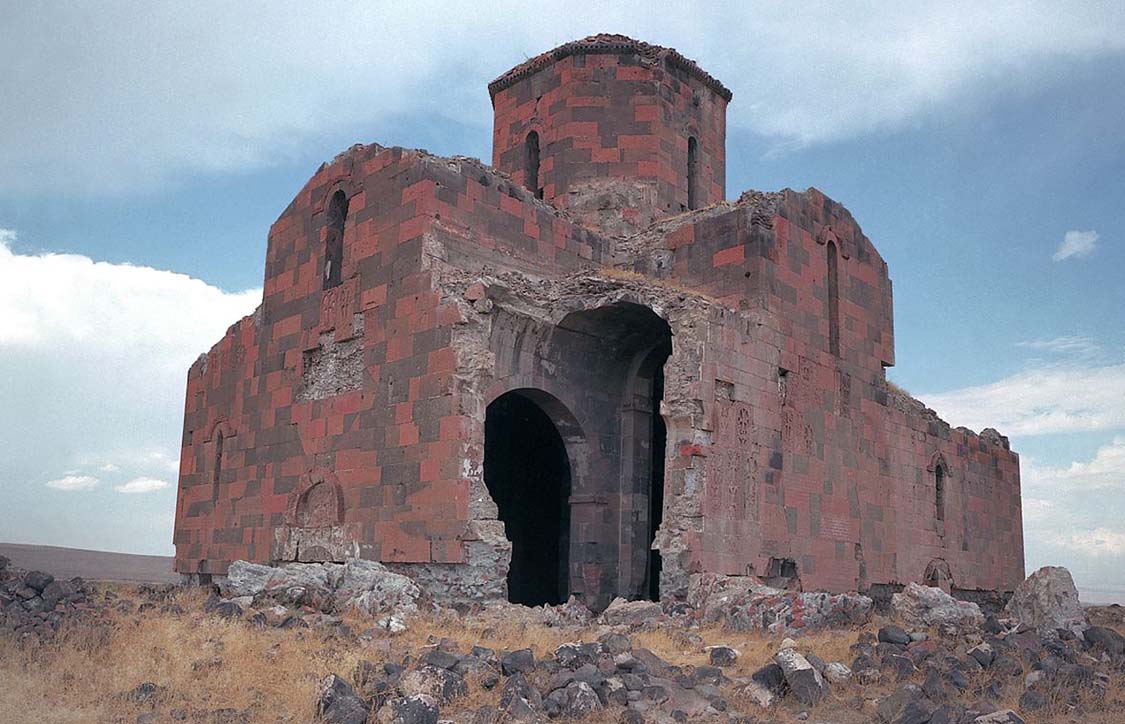An Interview with Dr. Christina Maranci
By Lucine Kasbarian
MEDFORD, MA — Dr. Christina Maranci, Arthur H. Dadian and Ara T. Oztemel Associate Professor of Armenian Art and Architecture at Tufts University in Medford, Mass., has issued a call to save the 7th century Mren Cathedral of Western Armenia, located in the Kars region of present-day Turkey. Prof. Maranci’s areas of expertise include Byzantine art and architecture, and the art and architecture of the Transcaucasus—principally Armenia. She is considered one of the world’s authorities on the Mren Cathedral.
According to Dr. Maranci, “the cathedral of Mren is now in danger of collapse. Constructed circa 638 AD, Mren is a masterpiece of world art and a product of the ‘Golden Age’ of Armenian architecture. Bearing an inscription naming the Roman emperor Heraclius, and a unique sculpted relief image of Heraclius returning Christendom’s greatest relic—the True Cross—to Jerusalem, Mren preserves precious material evidence for one of the most dramatic and yet poorly documented moments in history. It is also the largest domed basilica surviving from the region, and a key example of the architectural achievements of the seventh century.”


Dr. Maranci stresses that Mren may not be standing much longer. “Photographs from the 1990s to the first decade of the 21st century show the progressive collapse of the south façade. Now the entire south aisle lies in rubble on the ground, severely compromising the domed superstructure of the monument and opening the interior and its wall paintings to the elements,” she says. “The prospect of stabilizing what is left is at present doubtful, however, because of Mren’s position within a military zone in Eastern Turkey (Kars province) next to the closed Armenian-Turkish border. Visiting the site is forbidden.”
Dr. Maranci is campaigning to raise awareness about Mren’s precarious condition. “Mren has stood for over a millennium, bearing world history on its walls,” she says. Its collapse would represent a tragic loss to human knowledge.”
Following is an interview with Dr. Maranci.
Lucine Kasbarian: For years, scholars and travelers have been unable to obtain official permission to visit this site. When was the last time that architectural experts had access to Mren?
Christina Maranci: The last time anyone was able to do substantial scientific work there was in the 1960s when Nicole and Jean-Michel Thierry visited multiple times. I have never been there although I have tried to get permission.
LK: Observers say that Mren Cathedral seems to rival in size the Great Cathedral of Ani, and contains bas-reliefs and remnants of frescos not unlike those at the Cathedral of the Holy Cross in Aghtamar. Is forbidden access the reason why Mren is not as well known as these other two monuments?
CM: Mren and Ani are comparable in size, and Mren probably served as a local model for Ani Cathedral in its domed basilica layout and form, although Ani exhibits typical features of the 10-11th century Armenian architectural tradition. Mren has sculpted bas-reliefs on its portals and over some windows, and preserves fragments of wall painting in the eastern end. However, it bears nothing like the program of figural reliefs at Aght’amar—something that makes this church anomalous even in the Armenian tradition. Aght’amar’s wall painting is also better preserved. But the inaccessibility of Mren surely shaped its scholarly reception and public awareness about it. Toros Toramanyan, known as the father of Armenian architectural historiography, tells us that he himself was only able to visit it for one day.


LK: The website VirtualAni.org describes Mren as being one of four structures similar in design and which were likely built around the same time, the other three being the St. Gayane Church—built between 630 and 641 AD at Etchmiadzin; the church of St. John at Bagavan—built between 632 – 639 AD and north of the Lake Van region but now destroyed; and the Odzun Basilica—probably built in the first half of the 7th century AD in the Odzun region of Armenia. How does Mren compare in historical importance to these other structures?
CM: Gayane is obviously important for its connections to the conversion to Christianity tradition and because of its connections to the Patriarch Ezr, who is thought to have built it. If the church of Bagavan were standing today, it would have been, by far, the largest domed basilica in the region. Odzun is difficult to discuss, because it has been renovated so many times. While it dates to the early medieval period, it is generally thought to have a 9th century phase and perhaps even later ones. Mren is the only one of these monuments that is linked to the broader global world via its epigraphy and sculpture. It speaks directly to the network of relationships between empire, frontier, and local Armenian nobility. There is much more to say but this is a start, one hopes.
LK: Even as Mren is on the brink of collapse, would you say that it is one of the more intact monuments still standing in the Kars/Ani region?
CM: Well, it is hard to say. So many are in danger, so many have collapsed, and so many have been lost to historical record. But it is remarkable in many ways that a 7th century monument, so isolated and in such a seismic area, has survived as well as it has—so far.


LK: How can readers of this interview help bring attention to Mren Cathedral so that scholars and restorers might conduct important inspection and preservation work and so that Mren may become a protected site?
CM: I am in the midst of contacting UNESCO and, of course, nominating the monument to the World Monuments Fund. I will also be organizing a global petition in the very near future. In the meantime, readers who would like to get involved in the campaign to save Mren Cathedral may signal their interest by contacting me at: [email protected]










